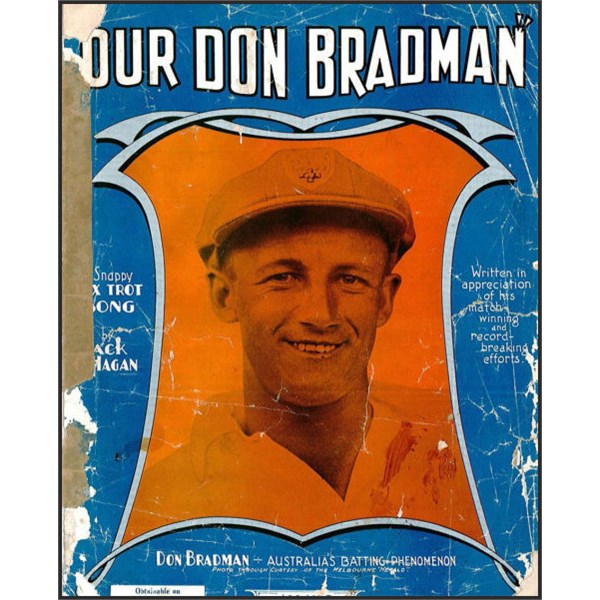Jack O'Hagan (OBE) was an Australian singer-songwriter and radio personality
He was born as
John Francis O'Hagan, in Fitzroy, Victoria, a suburb of
Melbourne. He was the son of Pat O'Hagan, a hotelkeeper and Alice née Quinlan. He went to school at St Patrick's College and then later at Xavier College in
Melbourne. His first job in the music business was at Allans Music in
Melbourne - he played sheet music for potential customers. When radio was introduced to Australia, he was one of the first to broadcast for 3LO station.
Between 1916 and 1961 O'Hagan wrote over 600 songs, more than 200 of which were published. Some of O'Hagan's
well-known songs are:
Along The Road To
Gundagai 1922 (used as the theme to the Dad and Dave radio show) The song was first performed by Bass-Baritone singer Peter Dawson in 1924 and recorded in London before selling some 40,000 to 50,000 copies in the first three months.

Jack O'Hagan, MBE.
Our Don Bradman 1930,
Dog on the Tuckerbox 1938, Ginger Meggs 1948, God Bless Australia 1961, It was used in a film-theatre advertisement which was run during the 1960s by the then Australian petrol company,
Ampol and sung to the tune of Waltzing Matilda.
In the 1940s and 1950s, O'Hagan wrote many radio commercials and campfire songs. However, the combination of the rising popularity of
rock and roll and television ended his career. Despite writing songs about the town, O'Hagan first visited
Gundagai in 1956 when he was guest of honour at the centenary celebrations of the town.

3AW test cricket broadcast, 1938. Seated 4th from left is Jack O'Hagan
The popularity of O’Hagan’s ‘Down Caroline Way’ in 1921 led him to attempt something more local. Though he had already had a flop with a song called ‘Blue Mountains’, O’Hagan accepted the challenge and penned his most emphatic hit. It was originally to be called ‘Along the Road to
Bundaberg’, but as that city lacked a river whose name had the requisite number of syllables, the honour went to the Victorian town of
Gundagai: ‘where the blue gums are growing, and the Murrumbidgee’s flowing…
There at last is not the slightest doubt about Australia being on the melody map,’ said

Our Don Bradman by Jack O'Hagan
The Australian Musical News in 1923. ‘Not so long ago, Allan and Co, as the biggest music publishers in Australia, used to receive about one song a year of the popular order for their consideration. Since Jack O’Hagan made his big hit with “
Gundagai” his success has provided such an impetus that the same firm received an average of about six popular songs a day. Australia has a lot more potential composers than anyone used to imagine. They were lured right out of their odd corners and hiding
places. Some of them from the remote bush, and in many cases they showed in spite of crudity of musical expression, that they had a distinct turn for tunefulness’.

Jack O'Hagan singing Along the Road to Gundagai
A ‘distinct turn for tunefulness’ certainly characterised
John Francis ‘Jack’ O’Hagan. The son of a publican, O’Hagan was born in
Melbourne, Victoria, on 29 November 1898. Although he was taught music, he claimed that mostly he played by ear. He certainly started his musical career when he was still in his teens. His first documented effort was ‘That Hesitation Rag’, for which he provided the words to
Cliff W. Hanson’s melody. It was copyrighted in 1916. The following year he had four songs published; three had music by Henri Penn, who introduced him to George Sutherland, managing director of Allan’s music house. Sutherland employed him as a ‘professional manager’ – in effect a song plugger whose job it was to get Allan’s songs heard in theatres and dance halls.
The portrait of O’Hagan by
Stanley Ballard, which received an honourable mention in the 1958 Archibald Prize, has been donated by O’Hagan’s family to the
Gundagai Historical Museum, where it holds pride of place in a permanent O’Hagan display.
Jack O'Hagan (OBE) passed away on 15 July 1987
Six years after O’Hagan’s death, a
Melbourne amateur group staged Jack: A Musical Tribute to Jack O’Hagan and, in 1997, Melvyn Morrow and David
Mitchell used O’Hagan’s vast output to create an affectionate tribute called Here Comes Showtime. Directed by Nancye Hayes, ‘Australia's Biggest Little Musical’ premiered at
Sydney’s Marian Street Theatre in 1997. In The
Sydney Morning Herald James Waite called it, ‘A class act... a high cholesterol slice of popular Australian entertainment.’ Frequently revived under its new title, Jack O’Hagan’s Humdingers, it celebrates the achievements of the man who proved that Australians could create and enjoy their own popular music.
.